USING WINCHES

| ||
| Use only one turn to pull in the slack jib sheet, because if you use more it will probably jam. | As the load comes on the sheet add more turns to increase friction. But, keep pulling on the tail. | The winch handle is used to increase leverage. Wind in the sheet the required amount and secure to cleat. |
| SELF-TAILING WINCH | RELEASING | |

| 
| 
|
| Here the tail is gripped by the top of the winch so both hands can be used on the handle. | To let the sheet out slightly, ease the turns round the drum with the palm of the hand, while keeping your fingers clear. | To release quickly, flick the turns off the top of the winch. |
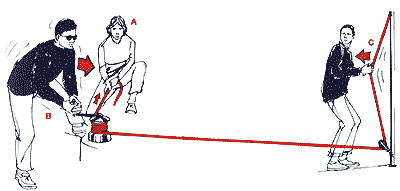
For speed, one person can tail (A) (pull the end of the sheet) while the other winds (B), putting his whole weight behind the handle. Pulling a loaded line at right angles and quickly taking up the slack is called swigging or sweating (C).
TACKINGor going about is putting the bow through the wind.

| 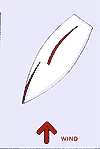
|
| Helmsman says 'READY ABOUT' and the crew uncleats the sheet, without easing it and says'READY'.The helmsman says 'LEE-OH' and pushes the tiller over and the crew releases the sheet. | |

| 
|
| As the boat goes through the wind the crew moves to the other side and starts pulling in the sheet by taking a turn on the winch. The helmsman also changes sides keeping the helm over. | |

| 
|
| The helmsman can help the crew by slowing the turn (giving a luff) allowing most of the sheet to be pulled in before the sail fills. Extra turns are put on the winch and the sheet tensioned. |
GYBING
Putting the stern through the wind.
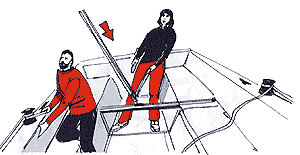
| 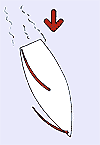
|
| The helsman says 'STAND BY TO GYBE'and the crew prepares the new sheet and says 'READY' The helmsman puts the wind on one quarter and the boom on the other by hardening (pulling in) the mainsheet. | |
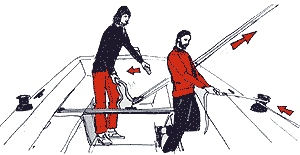
| 
|
| The helmsman says 'GYBE-OH'and turns the stern through the wind. As the boom comes across the main-sheet is released letting the friction in the blocks slow the boom down and the tiller is centred to slow the turn. The crew releases the old sheet and pulls in the new. | |

| 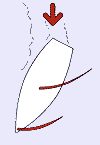
|
| When the boom is safely across the new course is steered and the main trimmed by pulling in the mainsheet. The crew trims the headsail for the new course. ALWAYS MIND YOUR HEAD AS THE BOOM SWINGS ACROSS THE BOAT. |

| |

| POLING OUT THE JIB With the wind astern the jib is often held out with a spinnaker or whisker pole. 1 Main and jib are sheeted in on a broad reach and the DOWNHAUL is connected to the pole while it is still stowed on deck. 2. Clip the pole to the mast keeping the front end on deck. 3. Clip on the UPHAUL. 4 Rig the AFTER GUY through a block right aft and outside everything. 5. With the pole end still on deck clip the LAZY JIB SHEET into the pole jaws. 6. Lift the pole with the UPHAUL to the height of the jib clew. 7. Haul the pole back until it nearly touches the shrouds. 8. Tighten the DOWNHAUL. 9 The pole is now fixed in the right position held by three lines. 10. The jib is still on the same side as the main, so the crew go back to the cockpit and pull in on the new sheet bringing the jib across until its clew is at the pole end. The main boom can be held out with a PREVENTER. (Stops the boom crashing across in an accidental gybe). |
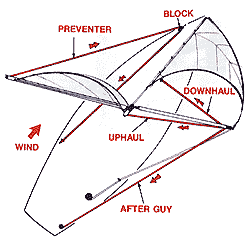
|
Дата добавления: 2015-07-24; просмотров: 776;
